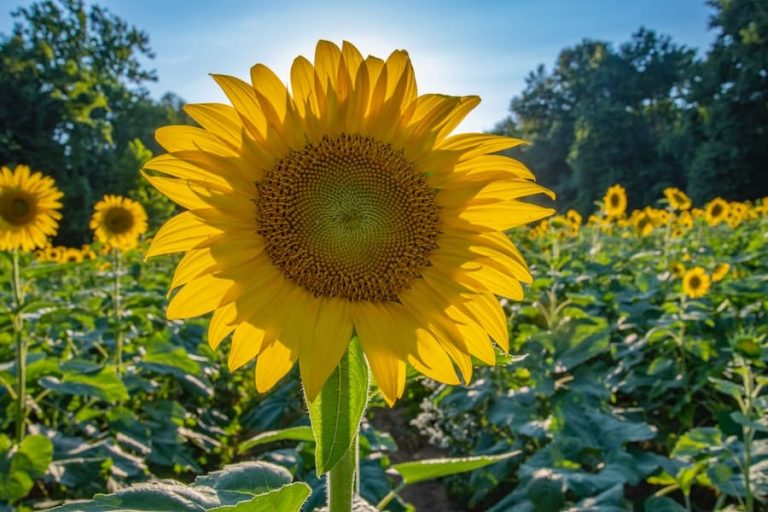Sunflower is a popular flower that you can easily find in any garden center or home. Because of its beautiful petals and height, the sunflower is also a favorite among gardeners. Growing sunflowers in a pot offer unique benefits to both the plant and the gardener. Whether you’re new to growing plants in pots or ready for something new this spring, learning how to grow a sunflower in a pot is simple and rewarding. (Zolpidem) Growing sunflowers in a pot involve some special considerations. Like most large plants, they’re thirsty and need plenty of water. Sunflowers are also heavy feeders and need rich compost with lots of nitrogen to thrive. Read on to learn more about how to grow a sunflower in a pot.
How To Grow A Sunflower In A Pot?
1. Selecting a Container
The large size and tall stature of sunflowers mean that they need large flowerpots to grow in, so start by selecting one that can hold at least 15 gallons of potting soil. Any similar-sized wide flowerpot will be enough for growing a summer sunflower, but it is best to choose a pot made of clay, like this one. Clay is porous and allows air to get through the soil more easily, which contributes to the freedom of movement needed by large plants like this. The sunny position should provide sunlight throughout the day and leave your plant enough space so it does not spread out too much into nearby paths.
2. Soil for Sunflowers in Pots
If your plant will spend the entire winter outside, it needs soil that can help retain water. However, not all potting mixes are the same. To determine what type of mix you’ll need in your sunflower pot, take a look at the pot’s label to see if there are directions for growing flowering plants in it. If there aren’t any, you may need to do some research online. Composts generated from grass clippings or whole leaves sold at garden centers also work well as growing media; generally, they contain high levels of nutrients, but they cannot retain water very well on their own because they become compacted over time. A couple of square sheets of plywood might make a good addition to these composts and distribute water right below the surface where your Sunflower needs it the most.
3: Avoid Harvesting Early
Resist the temptation to pick flowers when they look pretty – leave them until they have developed into seeds and lifted themselves off the flower horticultural sand or other coarse materials that allow drainage. If you need one, look for a sterile potting mix or create your own compost mixture for sunflowers that contains plenty of aeration but also a nutrient-rich fertilizer.
Why Grow Sunflowers In A Pot?
- Sunflowers are very striking colorful flowers. Orange color is very tedious to grow in Recirculating Aquaculture Systems, it fascinates the masses.
- Sunflowers are a huge attraction of Insects and Bats so they eat mosquitoes and flies.
- Wind Resistance is paramount with sunflower grow bags therefore they block greenhouse airflow, which maintains heat in the growing modules and hosts a microclimate atmosphere crucial to DR (Density Reefers).
- Sunflowers will help produce higher levels of oxygen for multiple other vegetables grown, this means that their root systems need less oxygen from plant roots to achieve the same results compared to growing macro-vegetables at much greater depth or volume e.g Cauliflower or Broccoli where slugs would otherwise feed on the leaves rather than being eaten by humans and crickets hatching into Orphans have NO HOUSEKEEPERS so realize that leaves are dinner, etc!! Nothing much escapes ‘human greed’ so they must be kept working to earn whatever they can!!
- Sunflowers are a wide field crop with many edible parts, tho the oil is used mainly as an additive in more things than you can possibly imagine just extracting this vegetable oil is hard & very small quantities at once for a long-term production lifetime.
Tips For Growing Sunflowers In Pots
- Plants tend to last a little longer in dry weather, but if plants do need water, it should be given at the root base of the plant, not over the plants themselves.
- Sunflowers grow best at 90% relative humidity. When plants are not getting enough relative humidity they will bounce on the ends of the stalks upon light gusts of air and collapse again once a steady stream of air runs over the plant itself.
- Sunflowers cannot withstand direct contact with water. Therefore, drainage is advisable to avoid root or crown rot. In outdoor growing conditions, make sure that a trench is dug under all pots of sunflowers to drain excess water away from the plants
- Sunflower seeds should be cultivated flat as opposed to upright when grown in a pot. Works best for root development. Always germinate sunflower seeds when it is still cold and dark outside for an optimal seedling root system to become armored fast enough to sustain higher temperatures later on but this armor can weaken the entire plant if planted at high intensity!
Conclusion
Sunflowers are an excellent choice for growing in pots. They prefer warm temperatures and lots of sun, and they are relatively easy to care for. When growing sunflowers in a pot, make sure to select a large pot and use a warm soil mix with plenty of water and fertilizer. You can also grow sunflowers in the ground, which can be more beneficial for cooler climates. With a little effort, you can grow beautiful sunflowers in pots and enjoy their bright colors and cheerful faces all season long.
